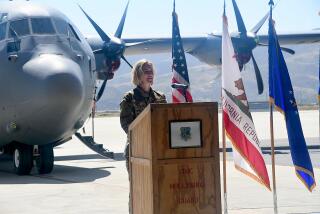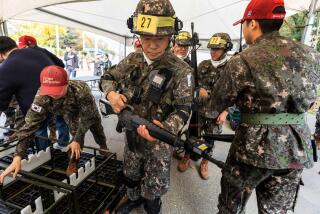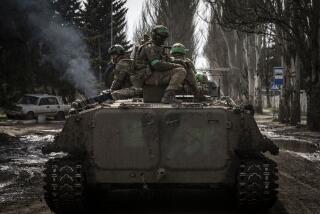Guard Unit Struggles to Gain Combat Readiness
FORT IRWIN — With the ground battle at full force, a U.S. M-1 tank pulled out of its desert fox hole, belched white smoke as a shield and started to pull away when a sudden problem stopped the tank in its tracks.
A posterboard-sized piece of paper, apparently a map, fluttered from the tank to the sand. A soldier hopped out and picked up the paper as the tank came under intense enemy fire. Just in time, the soldier got back on board. The tank growled to life and rumbled away into a cloud of amber sand and white smoke, safe for the time being.
“They were lucky,” said Army National Guard Maj. Will Bublitz, watching the scene from just a few dozen yards away. “Real lucky.”
Next time it might not work out so well.
The tank was being operated during a desert training exercise by members of the 48th Infantry Brigade, a 4,500-troop force of Georgia National Guard weekend warriors who may be thrust into a real war after their practice ends this month.
Questions have been raised about how combat-ready this group can ever become. The 48th will have spent 55 days at the giant National Training Center, more than for any other rotation. Troops normally spend 20 days here.
Earlier this month, U.S. Sen. Sam Nunn, D-Georgia and chairman of the Senate Armed Services Committee, met with members of the 48th and said they got high marks for dedication but fell short of being ready for combat.
The fitness of the unit also raises doubts of whether the military can continue to rely on Guard units and reserves to quickly get into combat form. The 48th is designed to round out the Army’s 24th Infantry Division, which already has been sent to the gulf.
Further casting a shadow on the 48th was the replacement of the head of the unit by his second-in-command. Guard officials said the reassignment of Brig. Gen. William A. Holland and the appointment of Col. James D. Davis were unrelated to the desert training.
In the field, guard members and a crack team of Army regulars who face them in exercises give mixed messages about the combat readiness of the 48th. “We could all use a lot more training,” said Sgt. Mark Tunner, a 19-year-old tank gunner. “We have a lot of motivation, but we don’t have a lot of cohesion.”
But Sgt. Ornan Savery of the Opposition Forces, or OpFors, said the Guard members have “improved 100%” since they’ve been here and he noted they have “killed” him twice in mock battles.
“I don’t get killed very often,” he said.
Prepared or not, it’s already been a long haul for these part-time soldiers.
Most of them have been living in the desert since Jan. 8, eating freeze-dried peaches and canned anchovies and passing the slow hours by playing chess and getting on each other’s nerves. Showers come about every two weeks. Their faces are sunburned and their hands are caked in dirt, as black as pitch.
Specialist John Phillips, 23, a surveyor from Ocilla, Ga., was in the desert for his one-year wedding anniversary Feb. 17. His wife is carrying their first child.
“It’s kind of rough,” he said, scooping tuna fish out of a can with a cracker. “I’m always getting my albums out and looking at pictures of her.”
Phillips was driving a Bradley fighting vehicle that was “hit” by enemy fire during a mock battle Friday. In the make-believe attack, the whole crew was killed.
The 48th has been taking part in exercises the Army touts as the among the most advanced in the world and the closest thing a soldier can get to combat short of a real war.
Indeed, the Army has been especially open to media requests to watch the training exercises as part of a military effort to assure the public that troops are well-prepared to join the ground war in the Persian Gulf.
In Friday’s exercise, about 500 guardsmen in some 80 vehicles came under attack by 800 OpFors soldiers who wear black berets with red stars and drive American-made vehicles modified to look like Soviet-built tanks and personnel carriers.
The troops fired weapons equipped with harmless lasers instead of live ammunition. Direct hits, or kills, are recorded by a loud alarm and a flashing yellow light. Near misses get a brief flashing light.
The Guard’s mission was to fend off the approaching enemy, get as many kills as possible and keep the enemy from passing through a sliver of sand between two ridges called Whale Gap.
The OpFors started moving at about 9:30 a.m., hiding behind a cloud of smoke. The OpFors took a sharp right to avoid a mine field and barbed wire erected by the Guard, moved along a ridge, then outflanked the Guard to the east.
Guard tanks that had dug in to the west scrambled to the other side of the battlefield or sped toward Whale Gap.
Two hours after the battle started, the OpFors reached the gap, although they lost some tanks along the way. The Guard suffered heavy losses.
Later, commanders would review the exercise by looking at information fed from the battlefield into a computer in a high-tech building soldiers call the “Death Star.”
An important question was whether the OpFors had better reconnaissance, enabling them to stay far clear of the western Guard forces and sneak around to the east, according to Bublitz, a Guard spokesman.
Another battlefield problem was the sorry case of Lt. Greg Norton’s M-1 tank, which broke a track the day before the battle and never got a replacement. The tank, a sitting duck because it couldn’t move, knocked out two OpFors tanks before getting killed.
Norton, sitting cross-legged on top of his tank after the battle, said he wouldn’t have stayed on a suicide mission if the enemy were shooting live ammo instead of harmless lasers.
“In a real situation, I’ll leave this damn thing,” said the 25-year-old welding equipment company employee from Florence, S.C.
More to Read
Sign up for Essential California
The most important California stories and recommendations in your inbox every morning.
You may occasionally receive promotional content from the Los Angeles Times.










